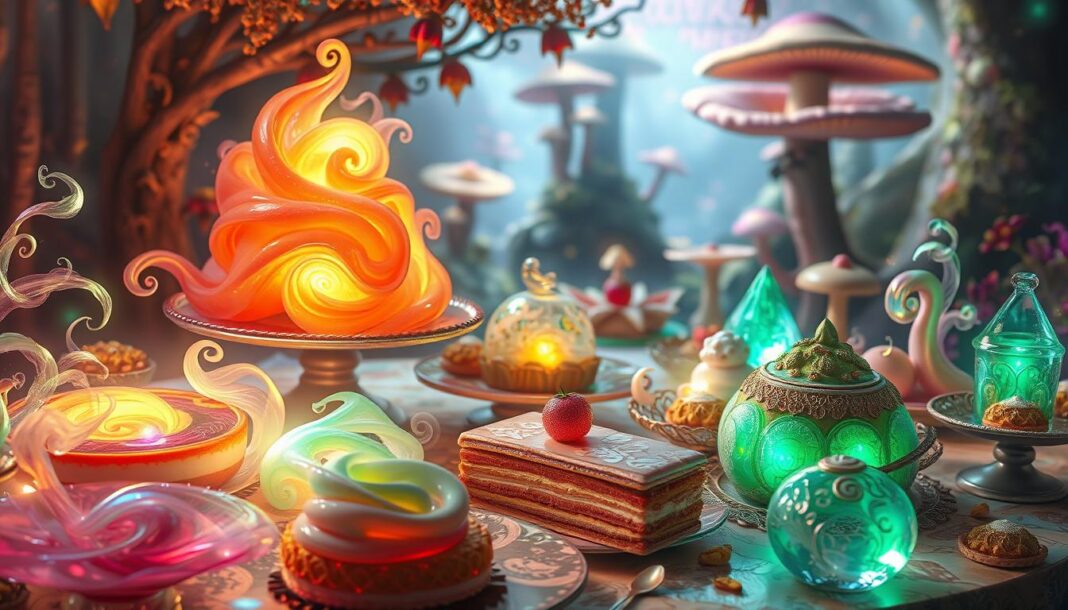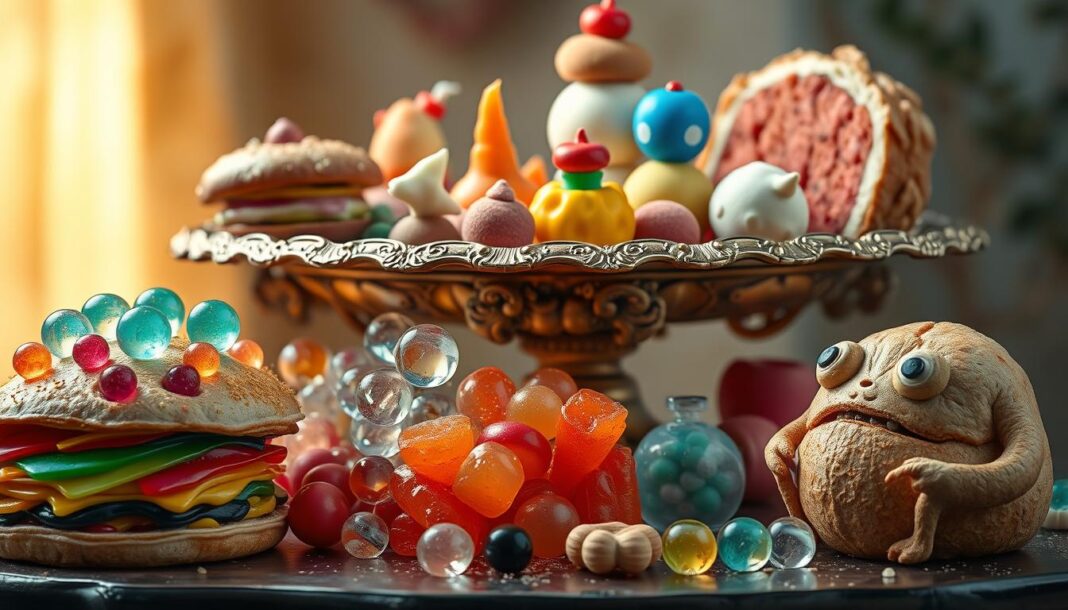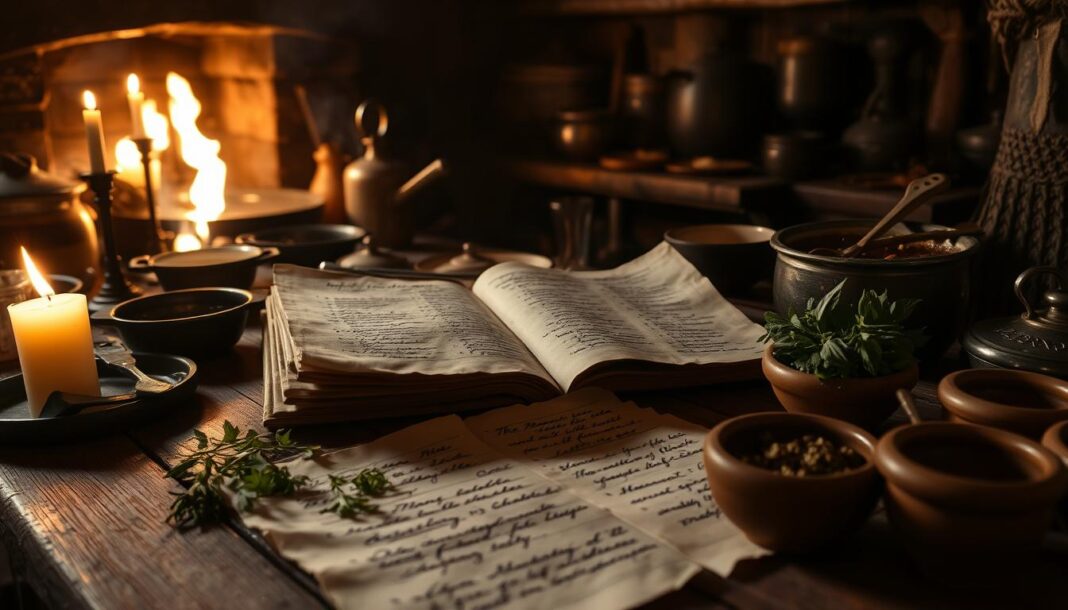When building a world, the food you create can reveal a lot about the culture, society, and morality of its inhabitants. In the realm of fantasy, culinary traditions can be just as imaginative as the creatures and characters that inhabit these worlds.
We explore how fantasy literature and media have crafted unique culinary traditions that reflect the distinct cultures, environments, and magical elements of their worlds. By examining the role of food in these fictional settings, we can gain inspiration for our own cooking adventures.
In this guide, we’ll delve into the cultural significance behind beloved fantasy dishes and provide practical recipes to recreate them. By the end of this journey, you’ll be equipped to host your own fantasy-inspired feast, worthy of kings, wizards, and adventurers alike.
Key Takeaways
- Discover how fantasy literature and media inspire unique culinary traditions.
- Learn the cultural significance behind beloved fantasy dishes.
- Explore practical recipes to recreate fantasy-inspired cuisine.
- Gain insights into the role of food in world-building and storytelling.
- Host your own fantasy-inspired feast with confidence.
The Magic of Fantasy-Inspired Cuisine
In the realm of fantasy, food becomes a powerful tool for worldbuilding, reflecting the complexities and nuances of the cultures that create it. Fantasy cuisine is not just about feeding characters; it’s about crafting a sensory experience that immerses readers in the world.
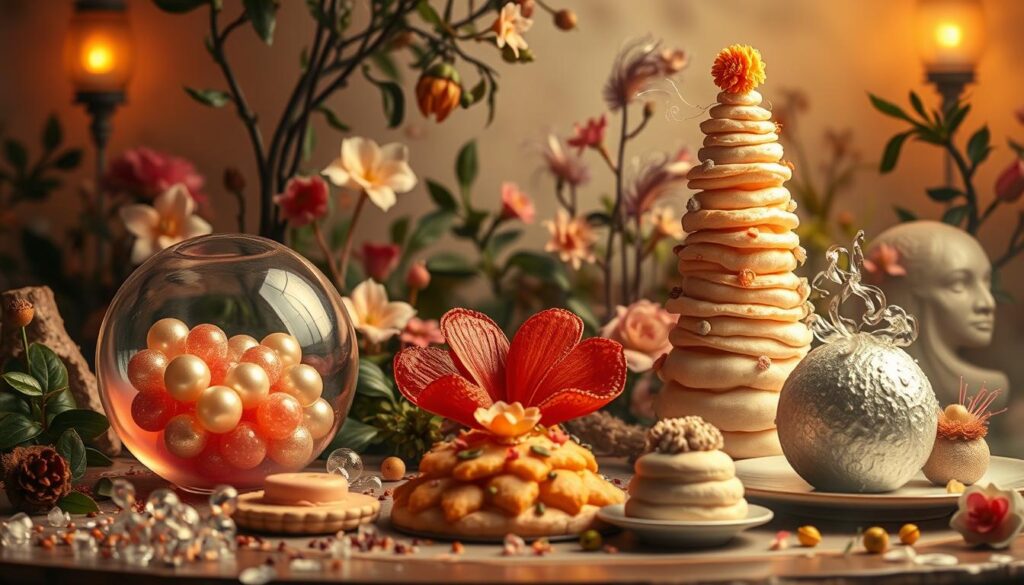
How Fantasy Food Reflects Worldbuilding
Fantasy food can reveal the intricacies of a world’s culture, history, and values. For instance, the preference for certain types of food can signify cultural identity, as seen in the diverse culinary practices depicted in fantasy literature.
The Cultural Triangle: Raw, Cooked, and Fermented
The culinary triangle of raw, cooked, and fermented foods provides a framework for understanding the cultural significance of different food preparation methods. We can apply Claude Lévi-Strauss’ culinary triangle to fantasy worldbuilding, exploring how different cultures perceive and utilize these food states.
| Food State | Cultural Significance | Fantasy Example |
|---|---|---|
| Raw | Often associated with barbarism or savagery | Orcs preferring raw meat |
| Cooked | Symbolizes civilization and cultural refinement | Elven cuisine emphasizing cooked dishes |
| Fermented | Represents a balance between nature and culture | Dwarves aging cheeses and spirits |
By understanding these cultural preferences, we can develop recipes that authentically represent different fantasy races and their unique approaches to food, enhancing the richness of our fantasy worlds.
Essential Ingredients for Your Fantasy Food Pantry
To create enchanting fantasy food, it’s essential to start with a well-stocked pantry that blends the ordinary with the extraordinary. The art of fantasy cooking lies in transforming familiar ingredients into magical culinary experiences.
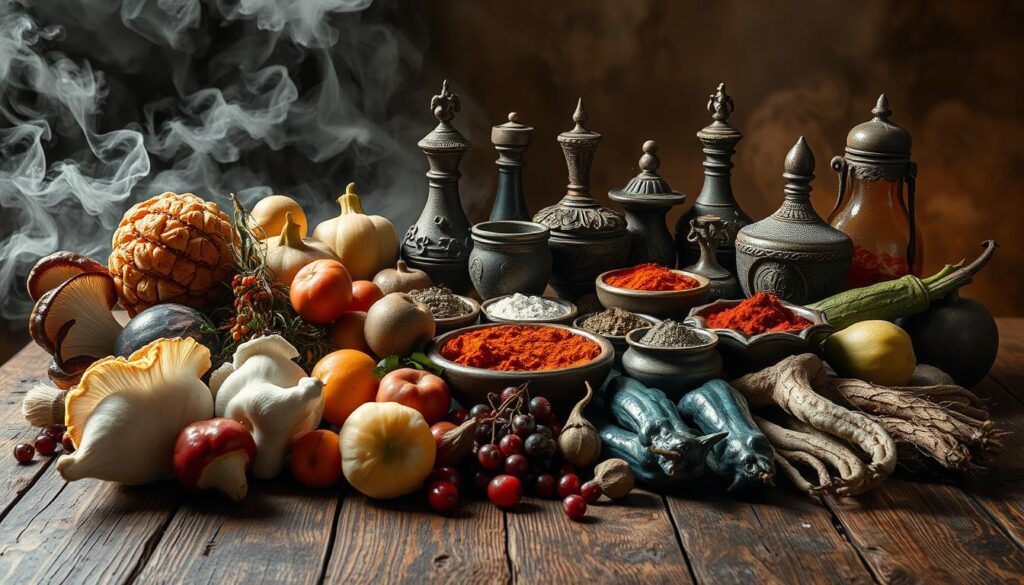
Staple Foods Across Fantasy Realms
Staple foods in fantasy realms often mirror those found in the real world, with a twist. Grains, legumes, and root vegetables form the backbone of many fantasy diets, providing sustenance for characters on their journeys. Food plays a crucial role in world-building, offering insights into the culture and geography of fantasy realms.
| Staple Food | Fantasy Twist | Culinary Use |
|---|---|---|
| Grains | Enchanted wheat, dragon’s barley | Bread, porridge |
| Legumes | Shadow beans, mystic lentils | Stews, salads |
| Root Vegetables | Magic carrots, wizard’s potatoes | Roasted, mashed |
Magical Substitutions for Common Ingredients
One of the simplest ways to add a touch of magic to your dishes is by making creative substitutions. For instance, eggs can be transformed into “dragon eggs” through tea-staining or herb infusion, adding both visual appeal and a hint of fantasy. The time spent preparing these ingredients can dramatically alter their flavor and texture, suggesting a magical transformation.
By using natural food colorings and experimenting with different preparation methods, you can turn ordinary dishes into vibrant fantasy creations. This approach not only delights the palate but also transports diners to fantastical realms.
Peasant-Inspired Fantasy Food Recipes
In the realm of fantasy cuisine, peasant-inspired dishes often tell the most compelling stories of rustic charm and hearty sustenance. These recipes, rooted in simplicity and resourcefulness, offer a glimpse into the culinary practices of fictional worlds. We explore how these dishes can be recreated, focusing on traditional techniques and ingredients that bring authenticity to fantasy settings.
Hearty Pottage and Rustic Stews
Hearty pottage and rustic stews were staples in medieval cuisine, and their appeal translates well to fantasy settings. These dishes, made with locally-sourced ingredients like vegetables, grains, and preserved meats, represent comfort food at its finest.
Handcrafted Fantasy Bread and Pastries
Fantasy bread traditions range from dark, hearty rye loaves to delicate herb-infused breads. Using traditional techniques like sourdough fermentation, we can create authentic fantasy-inspired breads. Savory pastries filled with cheese, vegetables, and preserved meats were not only delicious but also served as portable meals for travelers.
Noble Feasts and Royal Delicacies
In the realm of fantasy cuisine, noble feasts and royal delicacies play a significant role in defining the richness of a world. These grand culinary events not only showcase the wealth and status of the hosting nobility but also reflect the cultural and culinary sophistication of their realm.
Impressive Centerpiece Dishes
Centerpiece dishes are the crowning glory of any noble feast, often serving as both a visual spectacle and a culinary masterpiece. These dishes are designed to impress, featuring intricate designs and complex flavors that showcase the chef’s skill and creativity. Examples include elaborately decorated roasts, majestic seafood displays, and intricately crafted sugar sculptures.
Sweet Treats and Fantasy Desserts
No noble feast is complete without an array of sweet treats and fantasy desserts. These desserts not only satisfy the sweet tooth but also often incorporate fantastical elements, making them a highlight of the meal. From magical pastries to enchanted cakes, these desserts are as much about taste as they are about presentation and theme.
Thimble’s Fantasy Cookies Recipe
Thimble’s Fantasy Cookies are a delightful treat inspired by the charming world of “Tress of the Emerald Sea.” These cookies combine traditional baking techniques with a touch of fantasy, resulting in a delicious and unique dessert experience.
Emerald Sea Pie
The Emerald Sea Pie is a showstopping dessert inspired by Brandon Sanderson’s “Tress of the Emerald Sea.” This pie features a striking green filling that captures the novel’s maritime setting and vibrant imagery. The recipe balances visual impact with practical techniques, making it accessible to bakers of various skill levels.
| Dessert | Inspiration | Key Features |
|---|---|---|
| Emerald Sea Pie | “Tress of the Emerald Sea” | Striking green filling, maritime setting |
| Thimble’s Fantasy Cookies | “Tress of the Emerald Sea” | Traditional baking with a touch of fantasy |
Bringing Fantasy Food to Your Table
With our fantasy food recipes at hand, we can now transform our dining experiences into immersive adventures. Bringing fantasy food to your table involves more than just following recipes—it’s about creating experiences that transport diners to fictional realms. To achieve this, consider timing considerations crucial when planning fantasy meals, preparing components in advance to reduce stress and maximize enjoyment. Incorporating cheese into your menus can add authenticity and flavor complexity. By embracing the spirit of fantasy food rather than obsessing over exact authenticity, home cooks can create delightful meals that honor fictional traditions. This approach allows for creative flexibility, making food a central part of your culinary adventures, and with a little planning, you can enjoy these experiences over time.
